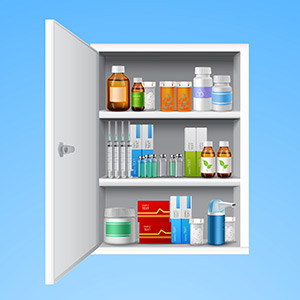
The time to have emergency medical supplies in your place is not when you need them. Planning ahead by being sure you have the medicine cabinet essentials listed below for illness or injury ensures you have less aggravation when the time comes.
Even though we all get sick from time to time, how you prefer to treat your illness may vary a lot. It’s important to have the following in your home in a place that is easy to lay your hands on (because its no fun to have to go hunting for things when you don’t feel well). However, its better if these things are not stored in the heat and humidity of a bathroom. In a box in a pantry or closet is best. I like a sweater sized storage box (12 or 16 qt size) with a label on it that says First Aid or Medical.
Well Stocked Medicine Cabinet Essentials
- Thermometer
Be sure you have an oral thermometer. It’s a great idea to check your temperature occasionally when you feel fine to learn what your normal baseline is. My son’s normal is over a degree less than the average, which is 98.6° F. - Acetaminophen
A pain killer for headaches and the pain of cold or flu. - Ibuprofen (an anti-inflammatory)
Though both acetaminophen and ibuprofen both are pain killers, they really are good for different things and sometimes one is just better than another. Ibuprofen is better for menstrual cramps and strains and sprains. - Decongestant if you can take it (see WARNING below).
NOTE: products containing pseudoephedrine (like Sudafed, which is my preferred), are kept behind the counter in pharmacies by law. You must ask the pharmacist and sign for them.
WARNING: Decongestants can be VERY dangerous if you take some heart drugs so be sure to ask your pharmacist if it’s compatible with any prescription drugs you take. - Cough medicine
Those containing dextromethorphan are good for just cough. If you get mucus, you might want to get one that also contains guaifenesin, an expectorant, which will help you clear the chest congestion. - Bandages
Bandages are the granddaddy of medicine cabinet essentials.
You want the stick on type in various sizes. You can buy a box with an assortment of sizes.
I get a lot of blisters, so always have some of blister band aids in the house. - Sterile Gauze and tape
An assortment of sterile gauze is also a good idea. You will need tape to secure gauze. Paper tape or surgical tape are great if you are sensitive to adhesives or have sensitive skin. - Rubbing alcohol
For cleaning tweezers and thermometers, cuts and scrapes (if you want more cleaning than soap and water). - Elastic Bandage
At least one. If you get a lot of sprains, you may need more than one. These are great for a turned ankle or wrist. - Hydrogen Peroxide
For cleaning out cuts after water. Also great for getting blood out of color safe washables (test in an inconspicuous area to be sure the dyes in the fabric don’t run). - Antibiotic ointment
Great for minor cuts, minor burns or blisters - Calamine lotion
Calamine helps itchy rashes, poison oak or ivy, or bug bites. - Tools
- Magnifying glass and tweezers: To remove Splinters
- Scissors: to cut tape and gauze
- Weekly pill container
Have one for each time of the day you regularly take pills and fill once a week. This makes keeping track of whether you have taken meds much easier and you can see ahead if you are running low. So if you take meds morning and night, then you need 2.
I suggest making a habit of filling these once a week. - Eyeglass repair kit for replacing screws if you wear glasses.
Check the expiration dates on all the drugs, lotions and ointments when daylight savings times changes (along with replacing batteries in smoke and carbon monoxide detectors). Also be sure that you have all your medicine cabinet essentials in good order at that time.

Leave a Reply